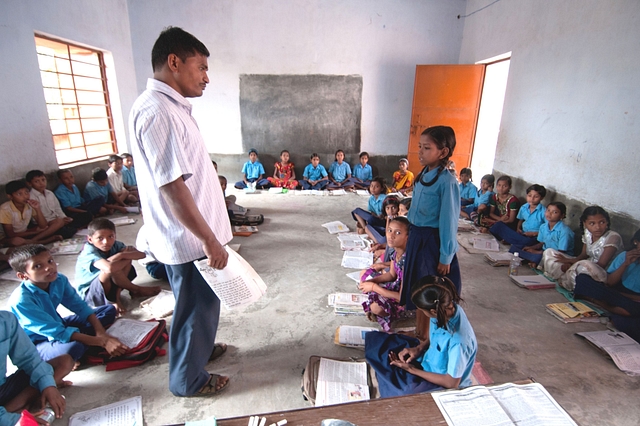
Teachers, Transparency And More: What Continues To Ail Bihar’s Education System And What’s Improving
Today, with over 88,000 schools, Bihar houses the second highest number of students after Uttar Pradesh, accounting for 10 per cent of the total national share of students in the school education sector.
With an Overall Performance score of 42 per cent, Bihar lies about 35 percentage points behind Kerala, the top-ranking State.
Home to the bastions of learning in ancient civilization, Bihar etched its name in history with the glorious institutions of Nalanda and Vikramshila, dating back to the fifth century.
The status of education in modern-day Bihar, however, paints a different picture - one that is in stark contrast to history’s greatest seat of learning. The most recent Census data pegs Bihar as the least literate State in India.
Today, with over 88,000 schools, Bihar houses the second highest number of students after Uttar Pradesh, accounting for 10 per cent of the total national share of students in the school education sector.
Rejuvenating the State’s education system is, therefore, critical for India to realise her full development potential.
Recently, the NITI Aayog launched the first edition of its School Education Quality Index 2019. The results corroborate the prevalent anecdote of low-quality education. Among the group of 20 Large States, Bihar ranks 17th in terms of Overall Performance, ahead of Punjab, Jammu and Kashmir, and Himachal Pradesh.
The Overall Performance score is the sum of the State’s score in the Outcomes Category including learning, access, equity, and infrastructure, as well as the Governance Processes Aiding Outcomes Category.
With an Overall Performance score of 42 per cent, Bihar lies about 35 percentage points behind Kerala, the top-ranking State.
Disaggregating its overall performance, Bihar’s ranks 15th out of the 20 Large States in the Outcomes Category.
This is largely driven by the below-average scores on learning outcomes, as measured by the National Achievement Survey (NAS), a representative competency-based national assessment.
In terms of foundational learning, as determined by the average scores in language and mathematics in Class 3, Bihar’s values stand at 67 and 63, while the top-performing States of Andhra Pradesh and Karnataka record values of 79 and 75, respectively.
Further, the index reflects the need for Bihar to strengthen its access and infrastructure parameters too, where the State once again records some of the lowest scores.
Even though Bihar records the highest adjusted net enrolment rate (ANER) at the elementary level at 100 per cent, the ANER at secondary school is just 54 per cent, depicting the need for the State to focus on enrolments at higher levels of education.
Additionally, the State was only able to mainstream 36 per cent of its identified out-of-school children (OoSC). Bihar could benefit by adopting best practices from Madhya Pradesh, Uttar Pradesh and Uttarakhand, where all identified OoSC were successfully mainstreamed into the education system.
With respect to governance processes, Bihar has recorded the best value in the ‘timely release of funds’ indicator. The State, harnessing its administrative efficiency, takes only one day to disburse the State’s share of funds to societies.
However, data from the other indicators highlights the presence of ample scope for improvement on every other parameter.
Owing to some of the lowest scores in indicators covering teacher adequacy, administrative adequacy and transparency, Bihar gets the second-lowest score in the Governance Processes Aiding Outcomes Category, ahead of only Jharkhand. Only 26 per cent of the elementary schools have teachers as per the Right to Education (RTE) norms; only 21 per cent of the schools have head-masters/principals and the vacancies in the academic support institutions are greater than 30 per cent.
Bihar is also yet to institute transparent online systems for teacher recruitments and transfers.
In spite of these shortcomings, in a positive sign that signals the fruits of the State government’s efforts, Bihar has shown progress in the Incremental Performance rankings, improving its score by 7.3 percentage points in just one year between the index’s base and reference period.
Despite a dip in its access scores and minimal improvements to school infrastructure, the State has recorded commendable progress in equity and governance processes, with improvements exceeding 10 percentage points.
The State’s performance in the equity domain is noteworthy. In fact, Bihar recorded the second-highest increment in this domain to the tune of 18.7 percentage points, just behind Andhra Pradesh. With the domain score surpassing 60 per cent, Bihar has made drastic progress in eliminating the difference in transition rates between the General Category and OBCs, a dominant population group, by over 14 per cent.
There are no differences between the language and math scores for boys and girls in Grades 3 and 5, displaying optimal gender parity in learning outcome attainment at these levels.
With efforts to enhance greater inclusivity, the State also showed improvements in the provision of aids and appliances to Children with Special Needs, increasing coverage by an admirable 33 percentage points.
Showcasing upward trends in teacher adequacy and an astounding improvement in accountability and transparency, where the percentage of schools with school development plans increased by 59 percentage points in one year, the Index establishes that the Government of Bihar is taking steps in the right direction towards reform.
While the release of the School Education Quality Index provides detailed insights into the performance of school education in Bihar, it also presents a fair analysis, depicting the relative performance of the State in comparison to other similar-sized States. The Index provides a way forward for the State of Bihar, augmenting existing initiatives of the Education government, and creating avenues for evidence-based policy reforms.
With targeted action, especially focused towards improving the State’s performance on the critical indicators identified, Bihar could be well on its way to regaining the glory of its past, reestablishing itself as a powerhouse for quality education.
As the land renowned for giving the world “Budh”, systemic reform in Bihar’s education sector is imperative to realise the vision of a New India.